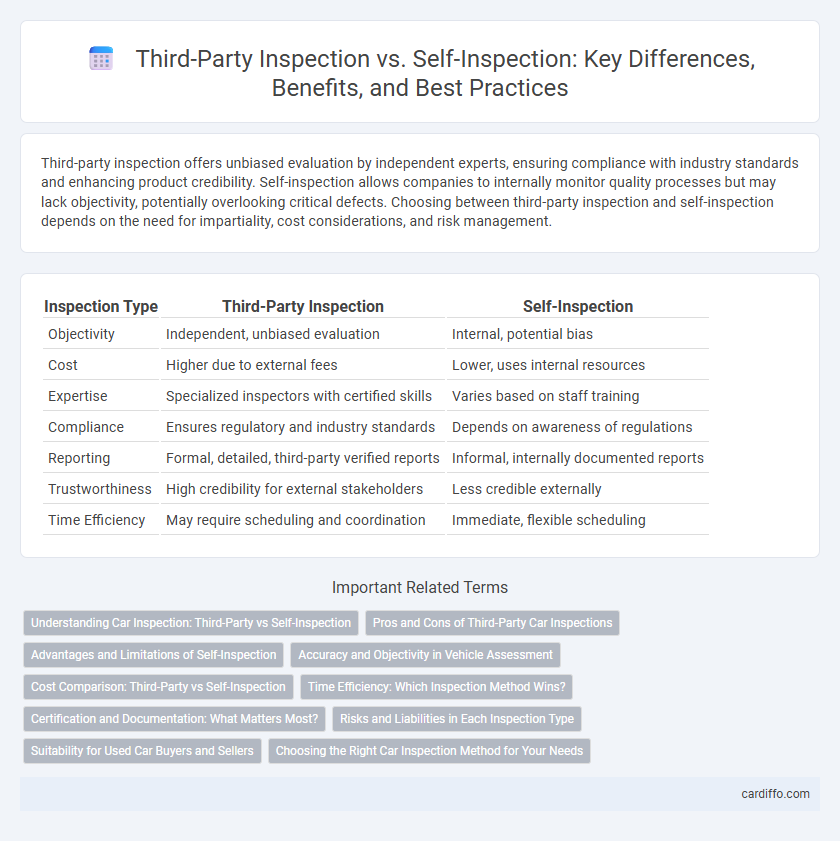Third-party inspection offers unbiased evaluation by independent experts, ensuring compliance with industry standards and enhancing product credibility. Self-inspection allows companies to internally monitor quality processes but may lack objectivity, potentially overlooking critical defects. Choosing between third-party inspection and self-inspection depends on the need for impartiality, cost considerations, and risk management.
Table of Comparison
| Inspection Type | Third-Party Inspection | Self-Inspection |
|---|---|---|
| Objectivity | Independent, unbiased evaluation | Internal, potential bias |
| Cost | Higher due to external fees | Lower, uses internal resources |
| Expertise | Specialized inspectors with certified skills | Varies based on staff training |
| Compliance | Ensures regulatory and industry standards | Depends on awareness of regulations |
| Reporting | Formal, detailed, third-party verified reports | Informal, internally documented reports |
| Trustworthiness | High credibility for external stakeholders | Less credible externally |
| Time Efficiency | May require scheduling and coordination | Immediate, flexible scheduling |
Understanding Car Inspection: Third-Party vs Self-Inspection
Third-party car inspections offer an unbiased evaluation by certified professionals, enhancing credibility and ensuring compliance with industry standards. Self-inspection allows car owners to perform basic checks for maintenance, but may lack the technical expertise to identify hidden issues. Utilizing third-party services is crucial for accurate assessment, particularly before purchase or sale, to avoid potential costly repairs.
Pros and Cons of Third-Party Car Inspections
Third-party car inspections offer unbiased and expert evaluations, reducing the risk of overlooked defects compared to self-inspections, ensuring higher reliability in pre-purchase decisions. However, they involve additional costs and may require scheduling, potentially delaying immediate vehicle assessment. Third-party inspections enhance transparency and trust in vehicle conditions but depend on the inspector's expertise and thoroughness for accurate results.
Advantages and Limitations of Self-Inspection
Self-inspection offers greater control over quality standards and immediate feedback, enabling faster correction of defects and continuous process improvement. Limitations include potential bias, lack of objectivity, and reduced credibility compared to third-party inspections, which may compromise compliance with industry regulations and customer trust. Organizations must carefully balance the cost savings and flexibility of self-inspection against the risk of overlooking critical issues that independent assessments could identify.
Accuracy and Objectivity in Vehicle Assessment
Third-party inspection services provide higher accuracy and objectivity in vehicle assessment by employing certified inspectors and standardized evaluation protocols, minimizing personal bias and errors. Self-inspection often lacks the rigorous methodology and impartiality, which can lead to overlooked defects or subjective judgments. Independent assessments offer more reliable validation for buyers and sellers, enhancing trust in the vehicle's condition and value.
Cost Comparison: Third-Party vs Self-Inspection
Third-party inspection generally involves higher upfront costs due to professional fees and certification expenses, but it can lead to long-term savings by reducing the risk of overlooked defects and associated rework. Self-inspection incurs lower direct expenses but may increase hidden costs linked to quality lapses, product recalls, or compliance penalties. Evaluating total cost of ownership indicates that third-party inspections often provide superior value through enhanced accuracy and regulatory compliance.
Time Efficiency: Which Inspection Method Wins?
Third-party inspection typically offers greater time efficiency due to specialized expertise and dedicated resources, allowing faster identification and resolution of issues. Self-inspection may save time initially but often leads to delays from potential oversight and the need for re-inspection or corrective actions. Overall, third-party inspection tends to minimize inspection cycle times and streamline project timelines.
Certification and Documentation: What Matters Most?
Third-party inspection provides certified verification and impartial documentation, enhancing credibility and compliance with industry standards. Self-inspection may lack formal certification but offers immediate control and customized reporting tailored to internal requirements. Certification and accurate documentation are critical for regulatory adherence, risk management, and fostering stakeholder trust in inspection outcomes.
Risks and Liabilities in Each Inspection Type
Third-party inspections mitigate risks by providing unbiased evaluations and reducing potential conflicts of interest, thereby limiting liabilities associated with inaccurate self-assessments. Self-inspections carry higher risks due to subjective judgment and potential oversight, increasing the likelihood of non-compliance and liability exposure. Understanding the balance between third-party accountability and the cost-efficiency of self-inspection is crucial for managing inspection risks and liabilities effectively.
Suitability for Used Car Buyers and Sellers
Third-party inspection offers used car buyers and sellers an unbiased, comprehensive evaluation, ensuring safety, condition, and authenticity, which enhances trust in the transaction. Self-inspection relies heavily on individual expertise and may overlook hidden defects, making it less reliable for assessing a used vehicle's true value. Buyers benefit from third-party reports for negotiating fair prices, while sellers gain credibility and quicker sales by providing verified inspection certificates.
Choosing the Right Car Inspection Method for Your Needs
Choosing the right car inspection method depends on factors such as cost, objectivity, and expertise. Third-party inspection offers unbiased, professional assessment with detailed reports, ideal for used car buyers seeking reliability. Self-inspection suits budget-conscious owners familiar with basic vehicle maintenance but risks overlooking critical issues without expert knowledge.
Third-party inspection vs self-inspection Infographic

 cardiffo.com
cardiffo.com